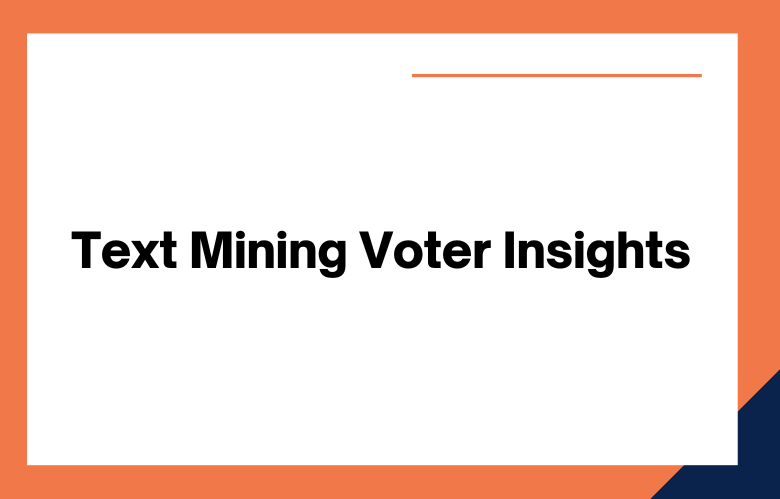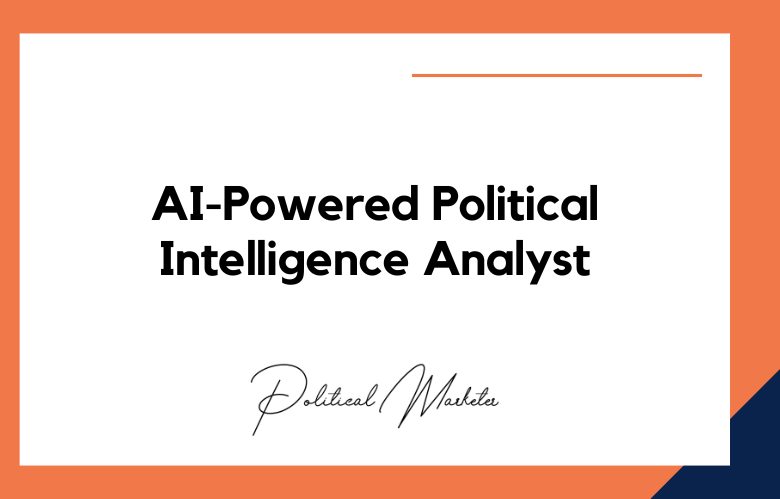Data mining techniques have been applied to various areas of the political process. One such area is text mining to glean insights from election campaigns. Text mining can analyze social media posts, media coverage, campaign literature, and more. By understanding what voters say, campaign managers can better target their messaging.
Text Mining Voter Insights from Election Campaigns
Text mining is a method of extracting information from unstructured text data. Using Natural Language Processing (NLP) algorithms, text can be processed and analyzed to extract insights.
Text mining can analyze sentiment, determining whether a piece of writing is positive, negative, or neutral. For example, words like “great” and “fantastic” would be assigned a positive sentiment score, while words like “terrible” and “disaster” would be given a negative sentiment score. Once all of the terms in a piece of text have been scored, the overall sentiment of the text can be determined.
Sentiment analysis can be used to track how public opinion changes over time. For example, suppose a candidate’s approval rating dropped after a debate. In that case, text mining could determine if that drop was due to negative media coverage or negative social media posts from voters. Campaign managers can adjust their strategies by understanding why approval ratings change.
Text mining can also be used to identify key themes and topics that are important to voters. For example, if many voters are discussing healthcare on social media, that indicates that healthcare is an essential issue and should be addressed by the campaign. Identifying key themes early on allows movements to develop messaging that resonates with voters.
How Text Mining can be used to gain Voter Insights
Text mining, also known as text data mining or textual data mining, is the process of extracting information from text. It’s a relatively new field that combines natural language processing, machine learning, and statistics. Text mining can discover what people say about a topic, spot trends, and even identify emotions. All this information can benefit election campaigns seeking to understand the electorate better.
There are several ways to mine texts for voter insights. One way is to use sentiment analysis to extract emotions from the text. For example, sentiment analysis could be used to analyze tweets about a candidate to see if more people are expressing positive or negative feelings about them.
Another way to mine texts for voter insights is through topic modeling, which identifies potential topics in a body of text. Topic modeling could be used to analyze debate transcripts to see the most frequently discussed issues.
How Text Mining Can Revolutionize Campaign Strategies in the Elections
Text mining, a form of natural language processing (NLP), holds immense potential to revolutionize campaign strategies in elections by extracting valuable insights from vast amounts of textual data. In the digital age, where social media platforms, news articles, blogs, and online forums serve as hubs of political discourse, text mining offers political campaigns a powerful tool to understand voter sentiments, identify key issues, and optimize their messaging strategies. This article explores how text mining can transform campaign strategies, providing a competitive advantage to candidates seeking to connect with voters and win elections.
Text mining enables political campaigns to analyze large volumes of textual data from diverse sources, including social media platforms like Twitter, Facebook, and Instagram, as well as news articles, blog posts, and online forums. By applying advanced NLP techniques, such as sentiment analysis, topic modeling, and named entity recognition, campaigns can extract valuable insights from this data, uncovering trends, patterns, and opinions that can inform their strategy.
The Power of NLP: Text Mining Voter Sentiments in the Election Season
The power of Natural Language Processing (NLP) in text mining has revolutionized the way political campaigns analyze voter sentiments during election seasons. In an era where digital communication dominates, NLP techniques offer campaigns unprecedented insights into the opinions, emotions, and preferences of voters, allowing them to craft more targeted and effective strategies. This article explores how NLP is transforming the process of sentiment analysis in political campaigns, enabling candidates to better understand voter sentiments and tailor their messaging accordingly.
NLP techniques enable political campaigns to analyze vast amounts of textual data from sources such as social media, news articles, and online forums, extracting valuable insights about voter sentiments and perceptions. Sentiment analysis, a key application of NLP, involves analyzing the tone and sentiment expressed in text to gauge public opinion. By applying sentiment analysis to textual data, campaigns can identify trends, patterns, and emotions that reveal how voters feel about specific candidates, issues, or events.
Enhancing Campaign Efficiency: Text Mining Voter Insights in 2024
Enhancing campaign efficiency through text-mining voter insights is poised to be a game-changer in the 2024 election cycle. As political campaigns continue to grapple with the challenges of reaching and engaging voters in an increasingly digital and data-driven landscape, text mining offers a powerful solution for extracting actionable insights from vast amounts of textual data. This article explores how text-mining techniques can empower political campaigns to enhance their efficiency, optimize their strategies, and maximize their impact on the electorate in the upcoming election.
Text mining enables political campaigns to analyze textual data from a wide range of sources, including social media, news articles, blogs, and online forums, to extract valuable insights about voter sentiments, preferences, and behaviors. By applying advanced natural language processing (NLP) techniques such as sentiment analysis, topic modeling, and named entity recognition, campaigns can uncover trends, patterns, and opinions that provide invaluable intelligence for decision-making.
Text Mining Is Becoming More Common in Election Campaigns
Text mining is becoming more common in election campaigns as more and more organizations realize its potential. In 2016, the Democratic National Committee hired data scientists to perform text mining on campaign speeches and social media posts to gain insights into voters’ feelings about the candidates.
The text mining results were then used to adjust the campaign’s messaging accordingly. Furthermore, it’s not just major political organizations using text mining during election campaigns; small movements are also starting to use it.
One of the most critical aspects of text mining is pre-processing the data, so machine learning algorithms can effectively analyze it. This involves tasks such as tokenization, stopword removal, and lemmatization.
Tokenization is splitting a text string into individual tokens (or words). Stopword removal is the method of removing words that are not information, such as “a,” “the,” and “of.” Lemmatization minimizes a comment to its base form so that different inflected forms are counted as the same word. For example, the terms “play,” “plays,” “played,” and “playing” would all be reduced to “play.”
After pre-processing the data, we can begin to train machine learning models. Many machine learning models could be used for this task, but some examples include Support Vector Machines (SVMs), Logistic Regression, and Naive Bayes.
By using it, we can make predictions on new data points. For example, we could use our model to predict how likely people are to vote for a particular candidate based on their social media posts or news articles they have read. We could also use our model to identify which topics are most important to voters.
Text Mining Voter Insights
There are several ways to mine text data for insights. One standard method is to identify and count the occurrence of specific words or phrases. This can be done using simple keyword searches or more sophisticated techniques like latent semantic analysis.
Another approach is to analyze the sentiment of text data, which can be done using methods like opinion mining and topic modeling.
Opinion mining, called sentiment analysis, is extracting opinions from text data. Topic modeling is a technique for uncovering the hidden structure in text data. This can be used to group documents by topic, identify the main themes in a collection of texts, or find similar copies.
The Role of AI in Text Mining Voter Data during the Election Campaigns
The role of Artificial Intelligence (AI) in text-mining voter data during election campaigns is rapidly evolving, empowering political campaigns with advanced capabilities to analyze, interpret, and leverage textual data at scale. In the modern electoral landscape, where digital communication channels abound, and voter sentiments are expressed across a multitude of platforms, AI-driven text mining plays a crucial role in providing campaigns with actionable insights into voter preferences, sentiments, and behaviors. This article explores how AI is reshaping the process of text-mining voter data, enabling campaigns to gain deeper insights, optimize strategies, and enhance engagement with voters.
AI-powered text mining tools leverage advanced natural language processing (NLP) algorithms to analyze and interpret vast amounts of textual data from diverse sources, including social media, news articles, blogs, and online forums. By processing this data, AI-driven text mining tools can extract valuable insights, uncover trends, and identify patterns that would be impossible to discern through manual analysis alone.
Conclusion
Text mining is a powerful tool that can be used to glean insights from election campaigns. By understanding what voters say, campaign managers can better target their messaging and stay ahead of public opinion shifts. Text mining can help movements develop more effective messaging and win more votes.
Call: +91 9848321284
Email: [email protected]











